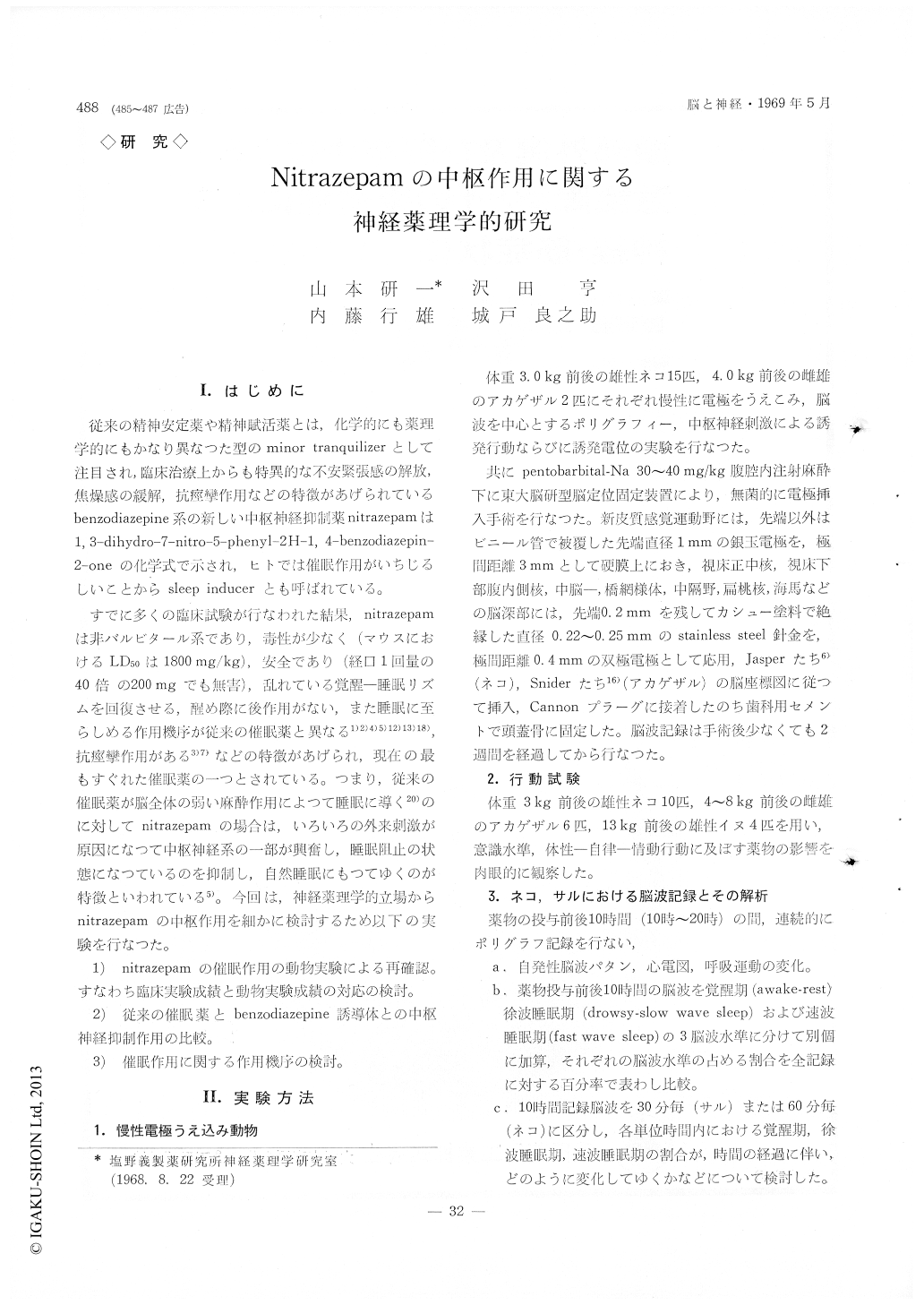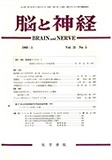Japanese
English
- 有料閲覧
- Abstract 文献概要
- 1ページ目 Look Inside
I.はじめに
従来の精神安定薬や精神賦活薬とは,化学的にも薬理学的にもかなり異なつた型のminor tranquilizerとして注目され,臨床治療上からも特異的な不安緊張感の解放,焦燥感の緩解,抗痙攣作用などの特徴があげられているbenzodiazepine系の新しい中枢神経抑制薬nitrazepamは1,3—dihydro−7—nitro−5—phenyl−2H−1,4—benzodiazepin—2—oneの化学式で示され,ヒトでは催眠作用がいちじるしいことからsleep inducerとも呼ばれている。
すでに多くの臨床試験が行なわれた結果,nitrazepamは非バルビタール系であり,毒性が少なく(マウスにおけるLD50は1800mg/kg),安全であり(経口1回量の40倍の200mgでも無害),乱れている覚醒—睡眠リズムを回復させる,醒め際に後作用がない,また睡眠に至らしめる作用機序が従来の催眠薬と異なる)1)2)4)5)12)13)18,抗痙攣作用がある3)7)などの特徴があげられ,現在の最もすぐれた催眠薬の一つとされている。つまり,従来の催眠薬が脳全休の弱い麻酔作用によつて睡眠に導く20)のに対してnitrazepamの場合は,いろいろの外来刺激が原因になつて中枢神経系の一部が興奮し,睡眠阻止の状態になつているのを抑制し,自然睡眠にもつてゆくのが特徴といわれている5)。今回は,神経薬理学的立場からnitrazepamの中枢作用を細かに検討するため以下の実験を行なつた。
The effects of 1, 3-dihydro-7-nitro-5-phenyl-2H-1, 4 benzodiazepine-2-one (nitrazepam), a new ben-zodiazepine derivative, on the central nervous sys-tem were analyzed behaviorally and electrophysio-logically in cats, dogs and monkeys with indwelling brain electrodes.
1. Continuous behavioral and electroencephalo-graphic arousal and/or excitation was observed with oral administration of nitrazepam (0.5~5.0 mg/kg) in cats. On the contrary, continuously stable slow wave sleep was obtained immediately after admini-stration of the drug (2.5~10.0 mg/kg) without any initial excitation to monkeys. Dogs seems to show an intermediate response to the drug (1~5 mg/kg) between cats and monkeys because initial excitation was followed by slow wave sleep.
2. Both defensive and aggressive behaviors were generally reduced in each animal, however, inhibi-tion of defensive behavior was not so evident in the case of monkeys. The taming effect was ob-served in unsocial animals and also the appetite increased in cats and monkeys.
3. Marked paralysis of the bind legs and distur-bance of gait were observed in each animal. Skel-etal muscle showed relaxation and evident grooming reaction was also noticed.
4. Dilation of the nictitating membrane (cat), rare vomiting (monkey) and increase of heart beat (cat) were observed.
In the observed spontaneous gross behavioral changes caused by nitrazepam, monkeys showed a response very close to that of humans.
5. The " rage reaction " induced by electrical stimulation of the N. hypothalami ventromedialis and/or central gray matter was strongly reduced with nitrazepam in cats, on the other hand, the inhibitory effect of the drug on the " induced be-havior " due to mesencephalic reticular stimuli was weaker than that of phenobarbital-Na.
6. In cats, the effect of nitrazepam on the spon-taneous EEG was as follows : a) An appearance of 14~16 cps waves in the somatosensory cortex, b) an inhibition of the hippodampal theta waves in the waking state, c) decrease of amplitude of all EEG leads, d) spike discharges in the amygdala and the hippocampus in the slow wave sleeping state and e) an inhibition of the hippocampal theta waves and a remarkable inhibition of characteristic 24~30 cps waves at the N. hypothalami ventromedialis in the fast wave sleeping state. On the other hand, stable slow waves in all EEG leads corresponding to behavioral sleep was observed in monkeys. The fast wave sleep which was not easily obtained in the normal control monkey was also periodically observed.
7. Behavioral and electroencephalographic sleep caused by nitrazepam in animals was easily blocked by external stimuli like a noise. Thresholds of EEG arousal reaction induced by electrical stimulation of the N. hypothalami ventromedialis, the mesencephalic reticular formation, the central gray matter and the peripheral nervous system were elevated in both on the somatosensory cortex and the hippocampus. Particularly, the appearance of the hippocampal theta waves was strongly inhibited. The inhibitory effect of nitrazepam on the ascending reticular activating system was weaker than that of phenobar-bital-Na. On the contrary, the threshold of the desynchronizing effect on the hippocampal theta waves caused by stimulation of the preoptic area was lowered by nitrazepam. Threshold change which were seen in the mesencephalic reticular and/ or the peripheral nervous stimuli indicated the dif-ferences of the effect between nitrazepam and chlor-diazepoxide on the central nervous system.
8. Results of analysis on the computed averaged-evoked response indicated that the sites of action of nitrazepam should be in the area from the mes-encephalic reticular formation, central gray matter and N. hypothalami ventromedialis to the hippocam-pus. Furthermore, most evident inhibition of the drug seems to be at the N.hypothalami ventromedialis, because the evoked response from the reticular for-mation to the ncocortex was not so inhibited, on the contrary, the response from the N. hypothalami ventromedialis to the somatosensory cortex was re-markably reduced.

Copyright © 1969, Igaku-Shoin Ltd. All rights reserved.


